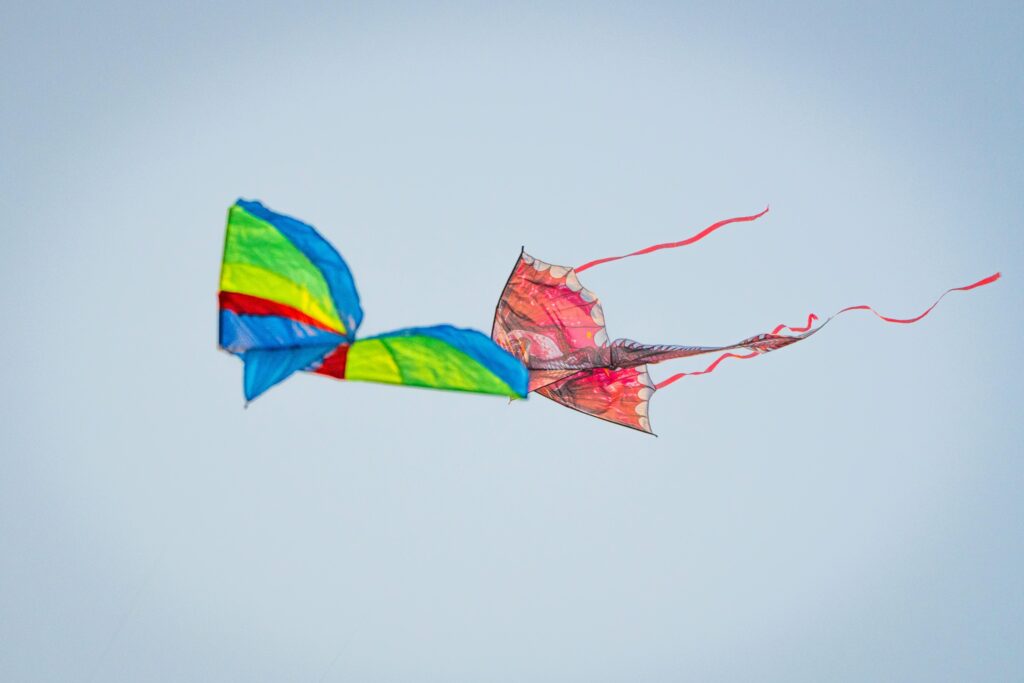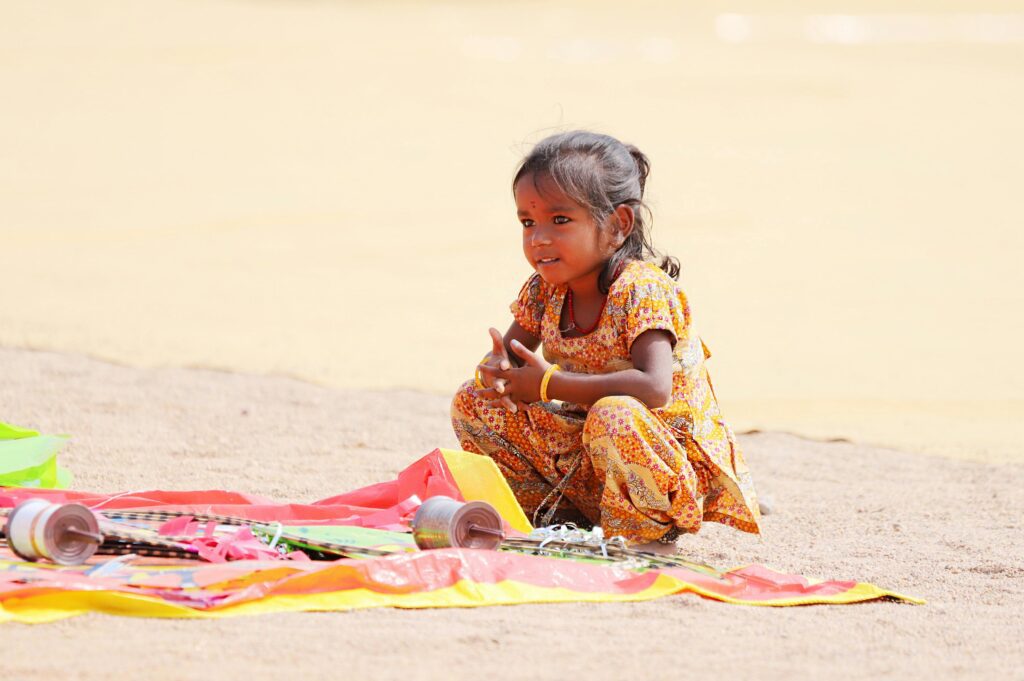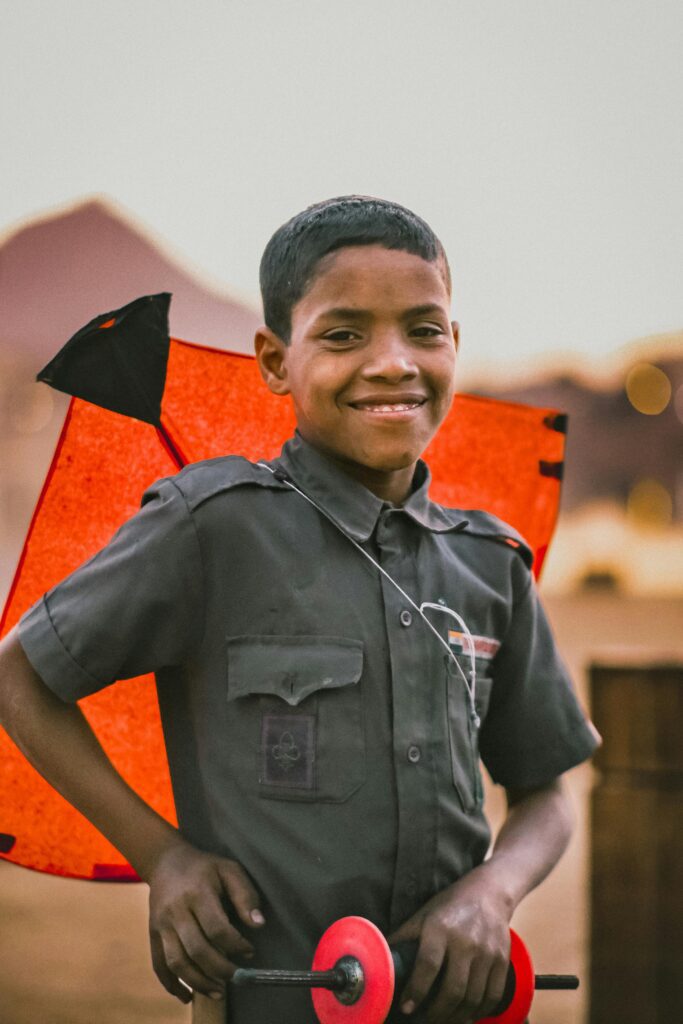
Table of Contents
Introduction to Kite Festival
The Kite Festival is perhaps India’s most engaging celebration. Every year, the skies are painted with colors, punctuated by hundreds of kites hovering high as families, friends, and communities gather to rejoice.
The festival is not merely kite-flying but very much attuned to India’s seasons, spirituality, and traditions.

The Kite Festival is observed during Makar Sankranti, a Hindu celebration marking the shift of the sun into the zodiac sign of Capricorn (Makar).
It is regarded as one of the most auspicious changes of the solar calendar, the end of cold winter, and the start of longer, warmer days.
In India as a whole, this day is celebrated with piety, happiness, and merriment, but in Rajasthan, Gujarat, and other northern Indian states, kite flying has become the hallmark of the festival.
For most families, flying kites on rooftops during Makar Sankranti celebrations is not merely entertainment but a tradition that unites generations.
The children, youth, and elderly all participate in the merriment, which becomes an essentially social affair. The value of this festival is that it brings together devotion, tradition, and enjoyment in one grand spectacle.
Historical and Cultural Significance of Makar Sankranti
Its history is as interesting as its celebration. It has been celebrated in India for ages, referred to in the ancient scriptures like the Mahabharata and Puranas.
It is among the few Hindu celebrations that follow the solar calendar, hence its date is fixed on 14th January each year (occasionally 15th).
Mythological Roots
In Hindu mythology, Makar Sankranti is the day when the Sun God starts his journey towards the north (Uttarayan), which represents light, positivity, and growth.
On this day, it is believed that Bhishma Pitamah of the Mahabharata decided to shed his earthly body, as this was the most auspicious time of Uttarayan.
Another myth attributes the festival to Lord Vishnu, symbolically ending darkness and negativity by vanquishing demons, representing new beginnings.
Agricultural Importance
The festival of Makar Sankranti is also agriculturally connected. It’s the harvesting season for crops like sugarcane, sesame, and wheat. Farmers celebrate their yield with gratitude by making traditional foods and sweets that symbolize prosperity and abundance.
Cultural Variations
The festival is observed differently in India:
In Punjab, it is referred to as Lohri.
It is referred to as Pongal in Tamil Nadu.
It is Magh Bihu in Assam.
In Rajasthan and Gujarat, the festive highlight is kite flying, popularly referred to as Uttarayan or the Kite Festival.
This regional variation demonstrates India’s rich cultural tapestry, all united under the canvas of the celebration of Makar Sankranti.
How the Kite Festival is Celebrated in Rajasthan
Of all the states, Rajasthan imparts a royal flavor to the Kite Festival. The desert blue skies, ancient forts, and colorful bazaars provide the most picturesque background for this vibrant festival.

The Rajasthanis, who love to revel in pomp and show, take this mundane activity of flying kites as large-scale phenomena.
Jaipur, the Pink City, is the hub of festivities. The Jaipur International Kite Festival at the Polo Ground draws kite flyers from around the globe.
There are kites of various shapes—dragons, airplanes, birds, and even characters from films. The view of thousands of kites covering the sky is breathtaking.
Rooftop Celebrations
For residents, the rooftops are the center stage. Terraces are occupied by families, armed with kites (patang) and spools of string (manjha).
The competitive urge runs high—cries of “Wo Kaata!” (translates to “I cut that kite”) ring out as people skillfully juggle their kites to outwit others.
One of the most iconic features of the Kite Festival in Rajasthan is the rooftop celebration.
Unlike many festivals that take place in public spaces or community grounds, kite flying is a unique event that transforms the rooftops of homes into arenas of skill, joy, and cultural expression.
Community Participation and Bonding
Rooftop kite flying brings together families, neighbors, and friends in a communal setting. In Rajasthan, it is common to see several households on adjoining terraces, sharing threads, kites, and sweets.
Children run across rooftops under the supervision of elders, while adults skillfully maneuver their kites, trying to cut their opponents’ strings.
This social interaction strengthens community bonds and fosters a sense of togetherness, making the festival as much about human connection as about the kites themselves.
Preparation and Strategy
Participating in rooftop kite flying is not a casual affair. Enthusiasts prepare weeks in advance, selecting the best kites, sharpening threads (manjha), and sometimes even crafting their own unique kite designs.

Each kite is carefully chosen to maximize aerodynamics and control.
During competitions, rooftop flyers employ strategy, teamwork, and skill to outmaneuver opponents, making the festival a thrilling test of patience, precision, and agility.
Sensory Experience
Rooftop celebrations are a feast for the senses. The sky turns into a canvas of vibrant colors, with red, yellow, blue, green, and patterned kites soaring against the pale winter sky.
The sound of laughter, cheers, and shouts of “Wo kaata!” (“I cut your kite!”) fills the air.
The smell of freshly made traditional sweets like til ke laddoo and gajak drifts across rooftops as families enjoy festive snacks.
The cold winter breeze, mixed with the excitement of flying kites, creates an atmosphere that is both exhilarating and joyful.
Cultural Traditions
Rooftop kite flying is not just recreational; it carries cultural significance. The act of flying kites symbolizes freedom, ambition, and aspiration.
During the celebration of Makar Sankranti, it is believed that the sunlight absorbed while flying kites brings health benefits and positive energy.
The rooftops become stages where tradition meets modern competition, preserving age-old rituals while encouraging creative expression.
Safety and Inclusivity
While rooftops are the primary venues, communities have developed informal rules to ensure safety.
Children are taught to be careful near edges, and adults supervise young flyers. People of all ages participate, making rooftop celebrations inclusive and family-oriented.
Even tourists visiting Rajasthan are often welcomed to join, turning the festival into a cultural exchange where locals and visitors share in the joy of kite flying.
Rooftops as Cultural Symbols
In Rajasthan, rooftops are more than functional spaces; they are symbols of community life and cultural identity.
During the Kite Festival, these terraces become lively hubs where people celebrate their heritage, showcase their skills, and experience the thrill of competition.
From historic homes in Jaipur’s old city to modern buildings in Udaipur, rooftops transform into stages for one of India’s most visually stunning and socially engaging festivals.
Food and Festivities
The Rajasthan Kite Festival is not complete without its cuisine. They feast on traditional foods like til ke laddoo, gajak, chikki, and dal pakori during the day.
They are prepared using sesame and jaggery and act as a source of energy and warmth during the winter season.
Udaipur and Jodhpur
Other urban centers such as Jodhpur and Udaipur also celebrate with the same fervor. Rooftops by lakes and forts offer breathtaking views of the sky filled with kites.
Traditional music and dances are enacted, and the whole city turns into a kaleidoscope of colors, sounds, and customs.
Rituals and Traditions on Makar Sankranti
Although the Kite Festival is the most outwardly visible, celebration of Makar Sankranti also involves religious and cultural rituals.
Holy Dips and Prayers
Numerous believers bathe in holy rivers like the Ganga, Yamuna, or Chambal in Rajasthan. It is thought to wash away sins and confer blessings of the Sun God.
Offering to Gods
Individuals prepare offerings of sesame seeds, rice, jaggery, and pulses, which are given away to the poor or presented in temples.
Swapping Tilgul
In most communities, sweets made of sesame (tilgul) are given with the words: “Tilgul ghya, god god bola” (Take this sweet and speak sweet words). This is a gesture of forgetting the past ill-will and beginning anew.
Flying Kites
The actual act of flying a kite has been a symbolic ritual—stretching skyward, welcoming freedom, and basking in sunlight. In the past, people used to think that sun exposure when flying a kite was a health remedy, which increased vitamin D levels in the winter season.
Bonfires and Social Gatherings
Community bonfires are set up in rural Rajasthan and people congregate to celebrate with folk songs and dances.
7 Fascinating Facts About Rajasthan Kite Festival
Jaipur Organizes One of the World’s Biggest Kite Festivals
Jaipur, popularly referred to as the Pink City, is the hub of the Kite Festival of Rajasthan. The Jaipur International Kite Festival is attended by kite flyers from across India and the globe, from nations such as Japan, Thailand, Brazil, and the USA.
Flyers take kites bearing complex designs from simple diamond-shaped kites to a range of dragon, bird, and cartoon-shaped kites.
It is not only about flying kites; it is a cultural extravaganza. Roofs, parks, and roads are filled with people who want to take part or witness the aerial show.
Jaipur is a living painting during the Makar Sankranti celebration, with colorful kites coloring the sky in front of historic forts and palaces.
The festival has made Jaipur a destination for cultural tourism, with hotels, craftsmen, and local bazaars seeing a huge economic upswing.
The Sky Turns into a Living Canvas of Colors
The most stunning thing about the Kite Festival is that the Rajasthan sky becomes a living canvas of colors as thousands of kites of all conceivable colors, sizes, and shapes float about.
This colorful sight during the celebration of Makar Sankranti signifies happiness, hope, and communal spirit.
Kids, adults, and even old participants jostle to know whose kite goes the highest or lasts longest in the face of wind and competing strings.
The sky is transformed into a rainbow of colors where vibrant reds, yellows, blues, and greens vie with the pastel colors of the winter sky to provide an experience one would never forget.
This colorful spectacle is not only an eye feast but also a celebration of man’s creative ingenuity.
Most families spend time weeks in advance making special kites, decorating them, and making strong strings (manjha) to engage in competitive kite flying.
Special Kite Competitions Bring Thrill and Excitement
Rajasthan’s Kite Festival is not only about recreation; it is a competitive sport. Competitors expertly fly kites to sever the strings of other kites with sharp manjha.
Winning the kite war is a point of prestige and skill, and competitions take place at local, city, and even international levels.
In these contests, there is a general excitement. There are cries of triumph such as “Wo kaata!” (“I cut your kite!”) ringing from rooftop to rooftop.
Rewards are given for the most innovative design of the kite, the best flying kite, and the best kite flyer of the day.
This competitive nature changes the Makar Sankranti celebration into an exciting social festival where strategy, patience, and skill are to be admired, and the festival is no longer a visual treat—it becomes a dexterity and coordination test.
The Festival Takes Place during the Harvest Time
The Kite Festival is closely associated with the farming calendar. It is observed on Makar Sankranti, the time when sugarcane, sesame, and wheat are harvested in Rajasthan and around.
The farmers offer their thanks for the harvest by engaging in kite flying, cooking festive foods, and distributing their bounty among family and neighbors.
In rural Rajasthan, there are accompanying community celebrations, as farmers and villagers gather on open fields or rooftops to celebrate nature’s richness as well as the delight of Makar Sankranti.
Therefore, the festival not only serves as a recreational activity but also a cultural reflection of thankfulness and prosperity and underscore its importance in agrarian culture.
Traditional Sweets Are Part and Parcel of the Festival
No Kite Festival in Rajasthan is complete without traditional sweets, which cannot be separated from Makar Sankranti celebrations. Sesame sweets such as til ke laddoo and gajak prepared using jaggery are exchanged among friends, relatives, and neighbors.
The sharing of these sweets is a symbolic act—it signifies harmony, bonhomie, and the sweetness of life. Through the festival, rooftops are frequently lined with bowls full of sweets, and the atmosphere is filled with the smell of freshly cooked delicacies.
These foods not only supply energy to sustain one through kite-flying hours but also symbolize the cultural richness of the festival.
Cultural Performances are an Enhancement for the Festive Atmosphere
Rajasthan’s Kite Festival is so much more than kites—it’s about art and culture.
The air is filled with traditional Rajasthani folk music like Kalbeliya and Ghoomar, while dancers in bright clothes dance through the streets.
Handicrafts, kite-making supplies, and decorations are all sold by local artisans throughout the festival.
The fusion of music, dance, and kite flying makes the Makar Sankranti celebration a multi-sensory cultural experience.
The tourists and locals alike are not only attracted to the aerial show but also to the depth of Rajasthan’s arts heritage showcased along with the festival.
The Festival draws Tourists from Across the Globe
The Kite Festival has received global recognition based on the spectacular celebrations in Rajasthan.
Thousands of visitors come from all over the world to take part in, observe, and capture the festival. Foreign kite enthusiasts usually bring kites from their countries, making it a worldwide kite-flying club.
The festival promotes tourism, supports local craftspeople, and celebrates Rajasthan’s vibrant culture and heritage.
The tourists also learn about traditional celebration of food, rituals, and customs of Makar Sankranti, making the festival a genuine experience of cultural exchange.
By bringing international fame to the festival, the Kite Festival guarantees that Rajasthan’s folk traditions are kept alive and enjoyed on a global platform.
Symbolism and Modern Relevance of the Festival
Kite flying on Makar Sankranti is not just for fun—it signifies dreams, aspirations, and freedom. Every kite flying higher symbolizes man’s desire.
Community Bonding: Neighborhoods and families come together, have food, and rejoice, which enhances social bonding.
Preservation of Tradition: Handmade kites and strings benefit artisans and preserve traditional crafts.
Modern Influence: Social media now boosts the festival, presenting Rajasthan’s skies to the entire world as a spectacle of wonder.
Conclusion
The Kite Festival is not an entertainment day; it is a rich cultural heritage of India symbolizing India’s oneness, diversity, and joy of living.
Originating from the festival of Makar Sankranti, the festival symbolizes the harmony of nature, thankfulness for the harvest, and the welcoming of new life when the sun begins its northward path.
Each kite that flies in the sky on this celebration is a representation of hope, aspiration, and liberation.
In Rajasthan, the Kite Festival is a special enchantment. The old-world sceneries of Jaipur, Udaipur, and Jodhpur come alive with hues and sounds, providing a rare mix of ancient tradition and contemporary celebration.
Rooftops turn into grounds of good-natured competition, where neighbors challenge each other with shouts of joy and laughter.
The smell of old-fashioned sweets such as til ke laddoo and gajak blends with the beat of drums and folk music, filling the air with a sense of bliss that cannot be beaten.
The festivity of Makar Sankranti transcends kite flying too. It inculcates virtues of sharing, humility, and gratitude.
Sharing sweets made of jaggery and sesame reminds people to sweeten relationships and forgive past differences.
The practice of worshipping the Sun God demonstrates a sense of respect for nature’s cycles and an appreciation of how deeply human existence is connected to the cosmos’ rhythms.
What sets the Kite Festival apart is its ability to unite communities. Families congregate on balconies, friends meet up, and travelers from all around the world participate, dissolving geographical and cultural frontiers.
It is not just a festival of India but a celebration of the world that rejoices, exudes energy, and harvests creativity.
In today’s fast-paced world, festivals like these remind us of the importance of pausing, looking up at the sky, and feeling connected—with nature, with our culture, and with one another.
The soaring kites symbolize the collective spirit of humanity: the desire to rise higher, to overcome obstacles, and to reach toward endless possibilities.
Therefore, the Kite Festival is much more than a seasonal fest. It is a social bond, a cultural heritage, and a spiritual reminder of hope and rebirth.
Rajasthan’s lavish celebrations make sure that this tradition is not only retained but also propagated globally and becomes an integral part of India’s rich legacy.
